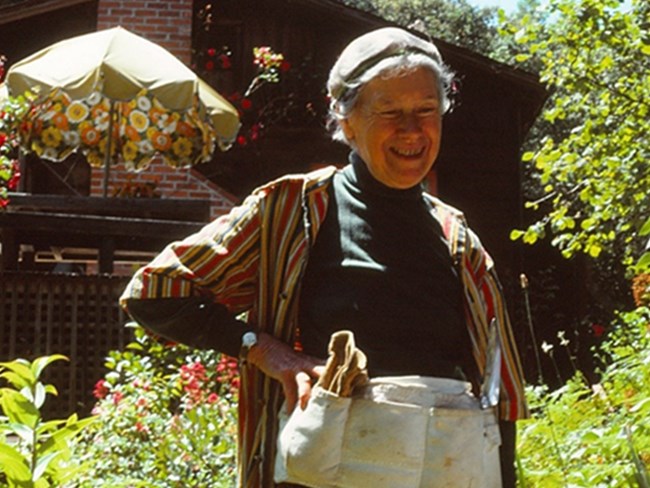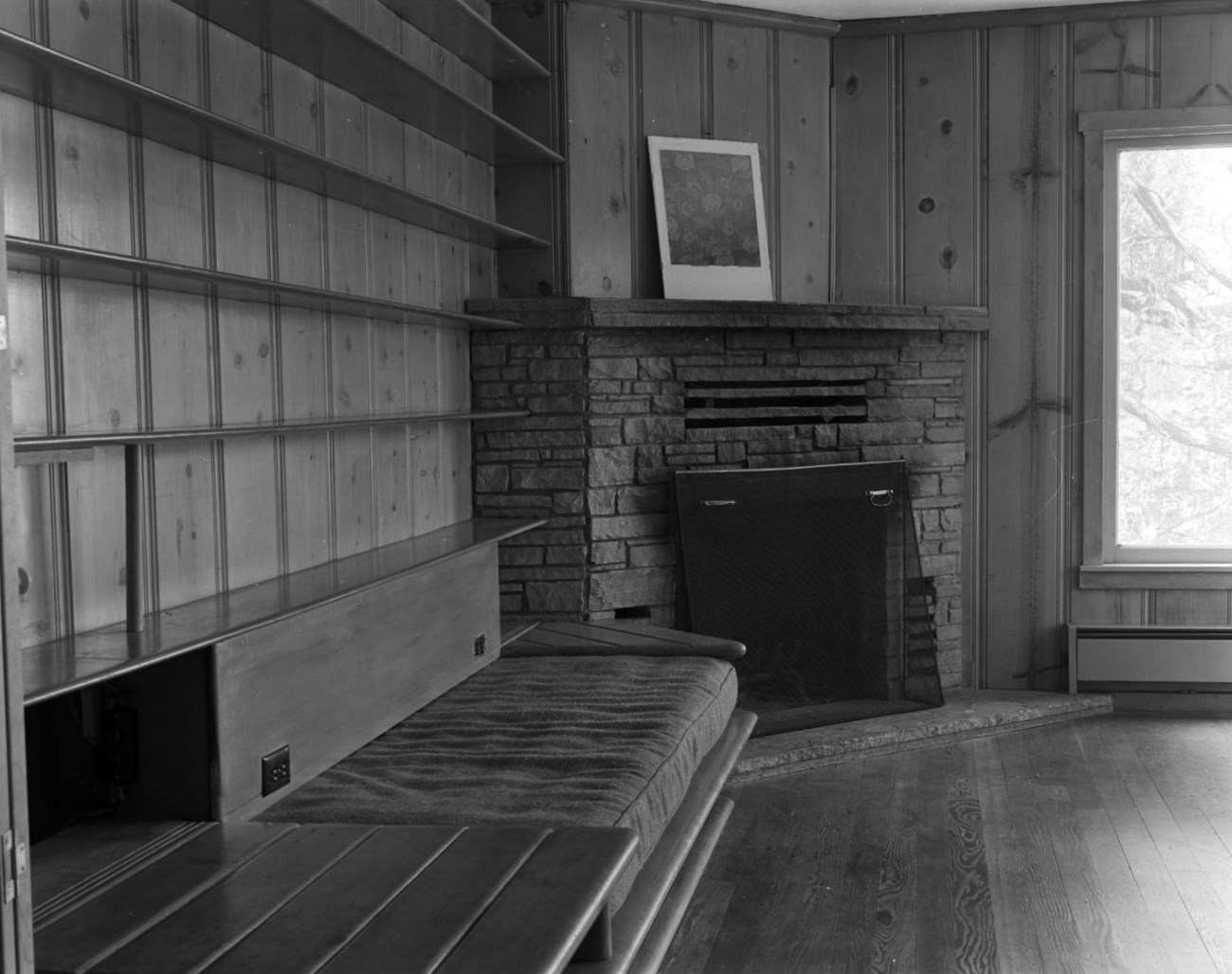Part of a series of articles titled Home and Homelands Exhibition: Resistance.
Article
Elsa Gidlow's "Chains of Fires"
- Duration:
- 2 minutes, 46 seconds
Elsa Gidlow's “Chains of Fires” poem, read by poet's friend Marcelina Martin
Article written by Nicole Martin, PhD

Courtesy of Hallie Iglehart Austen
"I know myself linked by chains of fire / To every woman who has kept a hearth."1
Born in 1898 in England, Elsa Gidlow spent her youth moving. First to Canada with her family, then New York as a young woman, before finally landing in the San Francisco Bay Area in 1926. Except for one year in Europe, she spent the rest of her life there.2 In 1953, she first laid eyes on "the place I knew must be home for as long as my earthly sojourn lasted." She later named the place – a ranch located above Muir Woods National Monument – Druid Heights, which she shared with a "small, extended-family community" as well as visiting artists, feminists, and bohemians.3
Elsa was a writer, poet, and philosopher. She wrote the first book of openly lesbian love poetry in North America, On a Grey Thread (1923). Unconventional to the core, she was attracted to philosophical anarchism – the intellectual critique of authority – but generally shied away from ideology. She preferred questions to answers and privacy to publicity. Druid Heights gave her the opportunity to embody her philosophy on a daily basis. As a sanctuary in the woods, she could create, free herself from "the ossified patterns of establishment culture," and most importantly, connect with and love women.4
Chains of Fires: The Hearthkeepers
In the video poem, Elsa’s friend Marcelina Martin, reads her poem "Chains of Fires" over photos and footage of Elsa, her home, and Druid Heights. The inspiration for the poem came to Elsa when she built a fire in the first home she ever owned. Alone and feeling defeated in the rundown house during a storm on the Winter Solstice of 1940, she desired a transformative ritual and began kindling a fire.
In that moment, she felt "there was born the joyous sense of connectedness." When she looked into the flames, she felt the presence of women – women she’d known but also elders from far back who had "kindled and tended sacred and domestic fires" with the same sparks that now lit her fire.

NPS Photo
These women had all known different homes. In the poem she smells in the smoke "hut and castle and cave / Mansion and hovel." She then sees, "mothers, grandmothers back to beginnings / Huddled beside holes in the earth / of igloo, tipi, cabin." The women she recalls lived in every type of home imaginable and yet have shared in the ritual of keeping a hearth. The process of starting "new fire" with the "coals of the old" links each fire to the last, connecting all women through this moment of renewal and rebirth.
After that night, Elsa saved the charcoal from her Solstice Fire to kindle the next year’s fire. She enacted this ritual the rest of her life, carrying the charcoal to Druid Heights where the other residents and visiting women partook each year on the Winter Solstice.5
Radicalness of Home: An Unintentional Community
"I was, and am, first that human person, then a woman, then a woman whose primary identification and loyalty is with women as lovers and friends."6
In her autobiography, Elsa strives to show that she was a whole human person like anyone else, despite who she chose to love. Rather than separating from society, she wanted to transform it. Living at Druid Heights was her experiment. She called it an organic, "unintentional community" that always welcomed and followed the needs of its participants.7
Following the needs of the people was how craftsmen Roger Somers and Ed Stiles – the two other legal owners besides Elsa – came to build over a dozen structures in an eclectic, natural style. It was also how Druid Heights became an enclave for those hoping to escape mainstream America – a place equal parts wild party and hard work - that welcomed all people. Ed Stiles remembered it as a time where "[a]nything was possible on any given day…it was just like wide open."8 Many famous artists visited or resided for a time, including the philosopher Alan Watts, the Pulitzer Prize-winning poet Gary Synder, and the feminist law professor Catherin Mackinon.

Library of Congress, Historic American Buildings Survey, HABS CA-2920-A. Photographed by Amanda Tomlin
As a lesbian, Elsa knew intimately the price of conformity. She valued deeply the fact that her home at Druid Heights allowed her to be self-directed and autonomous. She refused to marry a man just to gain economic security as many in her position felt forced to do. Near the end of her life, she envisioned Druid Heights becoming a retreat specifically for women artists, where "compatible women might be brought together for shared activity on many levels." Most importantly she wanted to encourage women's comradeship to counter how society – men, family, children – separated women from each other. Elsa passed away before this dream could be realized.9
"For No One Owns or Can Own Fire": Change in Ownership
In 1977, the National Park Service (NPS) purchased Druid Heights through eminent domain and incorporated it into Muir Woods National Monument. As an owner, Elsa was granted a twenty-five-year lease, but guests and non-legal tenants had to leave.10 When Elsa died in her home in 1986, the days of Druid Height’s palpable radicalism had long passed. A few long-term residents still live at Druid Heights and the unoccupied buildings have fallen into disrepair. In 2018, the NPS determined Druid Heights eligible for the National Register of Historic Places for a number of reasons including its contribution to the development of a creative alternative community and for Elsa's contribution to history and literature.
Today, Druid Heights is quiet, not unlike how Elsa first experienced it. Beginning with Coast Miwok women, the land has been home to many women who have tended sacred and domestic fires over the centuries. Elsa's dream lives on through Marcelina Martin, who performs Elsa’s Winter Solstice Fire ritual each year, and the many women who value connection and friendship between women above all else.11
1 Elsa Gidlow, “Chains of Fires,” in Elsa, I Come With My Songs: The Autobiography of Elsa Gidlow (San Francisco: Booklegger Press, 1986), 292.
2 “Elsa Gidlow,” Elsa Gidlow and Druid Heights.
3 Gidlow, Elsa, I Come With My Songs, 343. Roger and Mary Sommers discovered the property and convinced Elsa to go in with them on it, including fronting the down payment with support of friends, see 343-348.
4 Ibid., 356, 411.
5 All quotations from this section and the full poem can be found in Gidlow, Elsa, I Come With My Songs, 289-292.
6 Ibid., 301.
7 Ibid., 349-50.
8 Edmund Stiles, “Oral History of Edmund Stiles,” interview by Debra Schwartz, The Druid Heights Oral History Collection: A Collaboration Between the Mill Valley Historical Society, Mill Valley Public Library, and the National Park Service, May 9, 2018, 35-36.
9 Gidlow, Elsa, I Come With My Songs, 252, 411-12.
10 In her memoir, Elsa, who had gifted her portion of the land to the Society of Comparative Philosophy, claims she and the Society were not in favor of Druid Heights’ inclusion in Muir Woods National Monument. She thought the price the NPS offered when invoking eminent domain was low and fought the appraisal of its value. For more on Elsa’s view of the matter, see Gidlow, I Come With My Songs, 371-73.
11 “Druid Heights Artists’ Retreat,” Elsa Gidlow and Druid Heights.
Last updated: June 3, 2025
